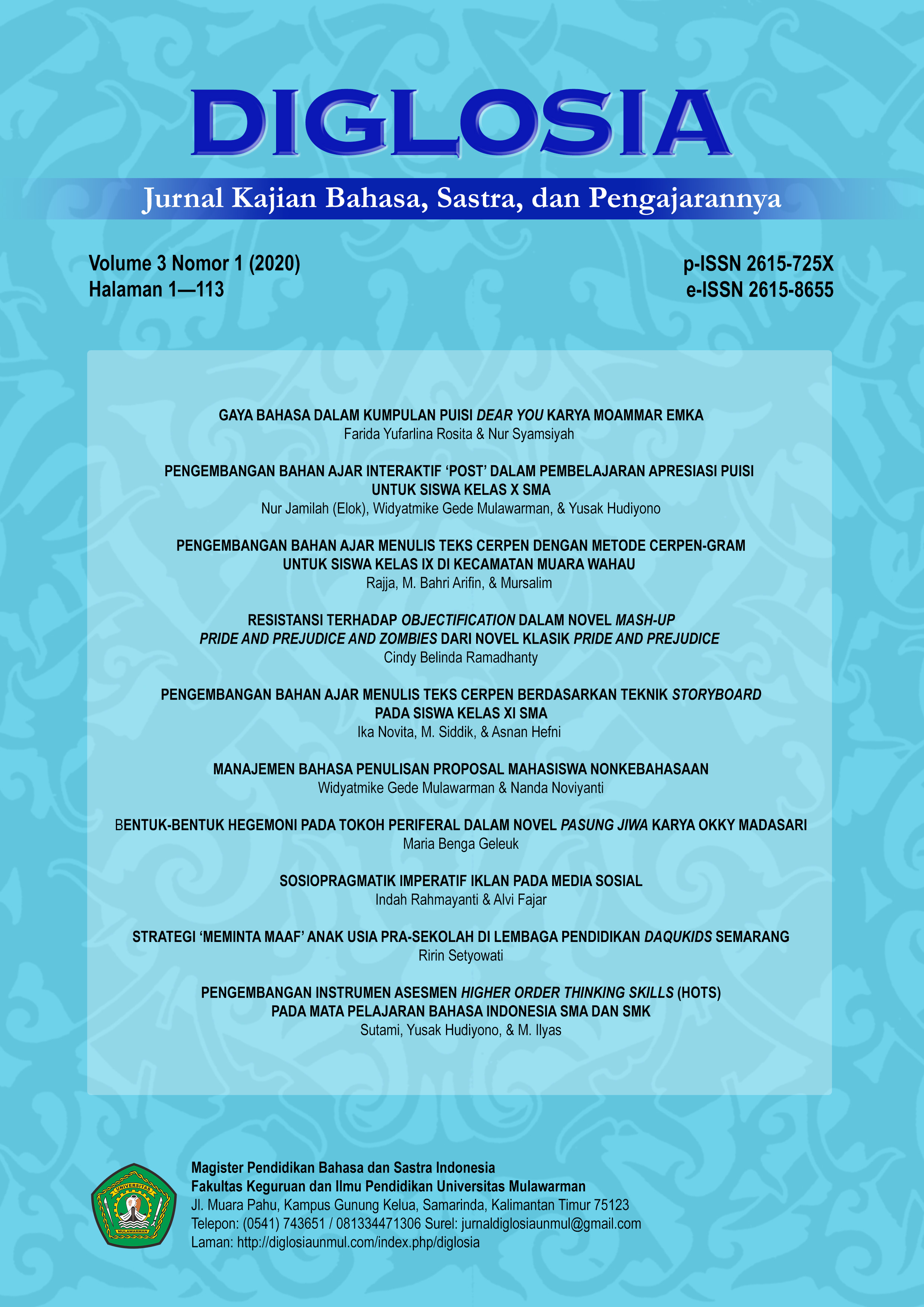Pengembangan Bahan Ajar Menulis Teks Cerpen dengan Metode Cerpen-gram untuk Siswa Kelas IX di Kecamatan Muara Wahau Development of Short Story Writing Teaching Materials Using Cerpen-gram Method for Ninth Grade Students in Muara Wahau District
Main Article Content
Abstract
The purpose of this research is to develop teaching materials for writing short stories using cerpen-gram method for grade 6 students in Muara sub-district, the scope of this development is limited to planning, materials, and evaluation in the process of developing teaching materials. The method used in this study is research and development (R&D), using the Brog and Gall. The data source that became the object of this research was grade IX students of SMPN 2 Muara Wahau. Development planning is carried out by analyzing student needs, experiences faced by students, preparing learning traps in the form of syllabus, lesson plans, materials, evaluation tools and preparation of learning steps with the Gram-short story method. The development of teaching materials for writing short text texts was declared to be very feasible through material expert testing (95.83%), method experts were declared very feasible (82.81%), education practitioners were declared very feasible (87.5%) with the same category that is very worthy. Small group trials (88.2%), large groups (87.13%), the results of student responses to small and large group trials (86.93%), and planning assessments were declared very feasible (84.66) for 1st observers, 2nd observer (88.33) with a very decent category. implementation evaluation (89.22%) by observer 1 and observer 2 (91.13%) Development of teaching materials for writing short text using the short-Gram method to improve student learning outcomes with results (87.31%). The teaching material product for writing short stories can be used as a source of support in the learning process and as an alternative source of independent learning by students so that they are more motivated to learn. Teaching products for writing short text can be disseminated to other schools in Muara Wahau district.
Downloads
Article Details
![]()
Every work in Diglosia: Jurnal Kajian Bahasa, Sastra, dan Pengajarannya is licensed under a Creative Commons Attribution-ShareAlike 4.0 International License.
Under the following terms:
- Attribution — You must give appropriate credit , provide a link to the license, and indicate if changes were made . You may do so in any reasonable manner, but not in any way that suggests the licensor endorses you or your use.
- ShareAlike — If you remix, transform, or build upon the material, you must distribute your contributions under the same license as the original.
- No additional restrictions — You may not apply legal terms or technological measures that legally restrict others from doing anything the license permits.
Authors who publish with this journal agree to the following terms:
- Authors retain copyright and grant the journal right of first publication with the work simultaneously licensed under a CC BY-SA 4.0 DEED Attribution-ShareAlike 4.0 Internationalthat allows others to share the work with an acknowledgment of the work's authorship and initial publication in this journal.
- Authors are able to enter into separate, additional contractual arrangements for the non-exclusive distribution of the journal's published version of the work (e.g., post it to an institutional repository or publish it in a book), with an acknowledgment of its initial publication in this journal.
- Authors are permitted and encouraged to post their work online (e.g., in institutional repositories or on their website) prior to and during the submission process, as it can lead to productive exchanges, as well as earlier and greater citation of published work.
References
Alwi, H., et al. (2003). Tata Bahasa Baku Bahasa Indonesia. Edisi Ketiga. Jakarta: Balai Pustaka.
Amalia, A. & Doyin, M. (2016). Pengembangan Buku Panduan Menyusun Teks Cerpen dengan Menggunakan Teknik Urai Unsur Intrinsik Bagi Siswa Kelas VII Sekolah Menengah Pertama (SMP). Jurnal Pendidikan Bahasa dan Sastra Indonesia, 5(1).
Depdiknas. (2008). Panduan Pengembangan Bahan Ajar. Jakarta: Dirjen Dikdasmen.
Endraswara, S. (2003). Membaca, Menulis, dan Mengajarkan Sastra. Yogyakarta: Kota Kembang.
Ghazali, A. (2009). Strategi Belajar Kooperatif dalam Belajar Mengajar Kontektual. Jurnal Pendidikan dan Pembelajaran (JPP), 9(1).
Harsiati, T., et al. (2016). Buku Guru Bahasa Indonesia SMP/MTs Kelas VII. Jakarta: Kemendikbud.
Hidayati, K. (2010). Menulis Kreatif Cerpen. Diperoleh dari http://kartikahidayati.blogspot.co.id/2010/12/menulis-kreatifcerpen.html
Himang, V. H. (2019). Pengembangan Bahan Ajar Menulis Cerpen Berbasis Pengalaman Siswa Kelas XI SMK. Diglosia: Jurnal Kajian Bahasa, Sastra, Dan Pengajarannya, 2(2), 93-102. http://diglosiaunmul.com/index.php/diglosia/article/view/21
Kemendikbud. (2015). 15 Naskah Terbaik Lomba Menulis Cerita Remaja (LMRC) 2014. Jakarta: Kemendikbud.
Kemendikbud. (2015). Pedoman Umum Ejaan Bahasa Indonesia. Jakarta: Depdikbud.
Khulsum, U., Hudiyono, Y., & Sulistyowati, E. D. (2019). Pengembangan Bahan Ajar Menulis Cerpen dengan Media Storyboard pada Siswa Kelas X SMA. Diglosia: Jurnal Kajian Bahasa, Sastra, Dan Pengajarannya, 1(1), 1-12. http://diglosiaunmul.com/index.php/diglosia/article/view/4
Lestari. (2015). Pengembangan Bahan Ajar Menulis Cerpen Berbasis Proyek dengan Pendekatan Kontekstual untuk Meningkatkan Kemampuan Siswa Menulis Cerpen. Metafora, 2(1).
Masroroh, A. (2015). Pengembangan Modul Pembelajaran Menulis Cerpen Berbasis Pengalaman (Experiential Learning) Untuk Siswa SMP/MTs. Diperoleh dari https://eprints.uny.ac.id/27649/
Mawene, A. (2015). Lagu dan Cerpengram. Jawa Timur: Surya Pena Gemilang.
Nurgiyantoro, B. (2013). Teori Pengkajian Fiksi. Yogyakarta: Gadjah Mada University Press.
Nurhadi, et al. (2007). Bahasa Indonesia untuk SMP Kelas IX. Jakarta: Erlangga.
Pranoto, N. (2011). Creative Writing Telaga Inspirasi Menulis Fiksi. Bogor: Rayakultura.
Sufanti, M. (2013). Pembelajaran Bahasa Indonesia Berbasis Teks: Belajar dari Ohio Amerika Serikat. Diperoleh dari http://hdl.handle.net/11617/3363
Sugiono, et al. (2013). Kamus Besar Bahasa Indonesia. Jakarta: Gramedia Pustaka Utama.
Sugiyono. (2016). Metode Research and Development. Jakarta: Pustaka Media.
Sun, P. K. (2016). Menggali Passion Menulis Cerpen dengan Cerpen-gram. Jakarta: Gramedia.
Suyuti, et al. (2015). Kamus Bahasa Indonesia Baru. Bandung: Nala Cipta.
Trianto, A. (2014). Buku Siswa Bahasa Indonesia SMP/MTs Kelas IX. Jakarta: Kemendikbud.
Tysna, A. W. I. (2014). Ragam bahasa. Diperoleh dari https://www.academia.edu/9534983/makalah_bahasa_indonesia_ragam_bahasa
Zabadi, F., et al. (2014). Bahasa Indonesia Wahana Pengetahuan SMP/MTs Kelas VII. Jakarta: Kemendikbud RI.

